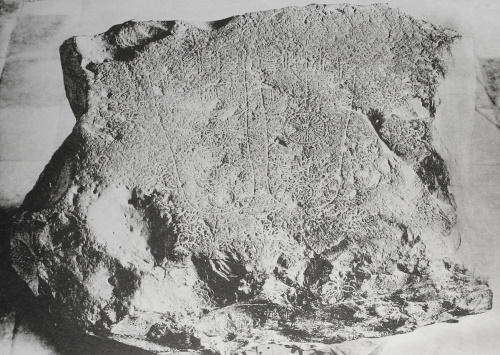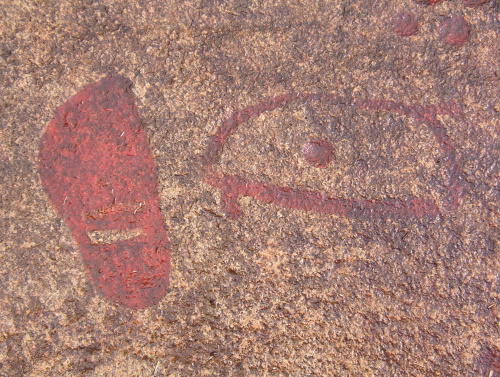Blog Connections
Petrosomatoglyphs
Among the farewell gifts from my last (and final?) job was a book called “God. An anatomy”. It describes the depiction of body parts of God in early sculptures and paintings as found in the region where Christianity developed. It is chock-full of descriptions of places where such examples can be seen. Of course, I immediately considered whether a new connection could be derived from it. However, depictions of (parts of) God are rare at WHS, or are so small or precious that they have been moved to museums.
But we already have a similar connection, about a subject which the book also touches slightly: Petrosomatoglyphs. These are (supposed) impressions of part of a human or animal body incised in rock. I updated the connection details, deleted a couple, and found some more; the sources used can be found for reference in the weblinks on the connection page.

Divine Footprints
These prints are often used in religious ceremonies, a practice that is present in all main religions.
Christianity
- In the Church of San Sebastiano Fuori le Mura in Rome, the alleged footprints of Jesus can be seen. They are related to the apocryphal episode called Quo Vadis, where St. Peter fled Rome, and met Jesus at the Via Appia who was going the other way “to be crucified again”.
- At Kernavë, a stone has been found with 'footmarks of the Christ, the Virgin Mary and the lamb'. I suspect it is in the on-site museum, but have failed to find pictures of it.
Islam
The veneration of the Footprints of the Prophet is common in Islam as well, although it is rejected by the orthodox. This article explains well how it developed.
- The tradition may have started at the Dome of the Rock in Jerusalem, where there are "marks" of the footprint of Mohammed (made as he stepped upon it to mount his horse Barak when commencing his ride to Paradise), Barak's Hoofprint and the hand/fingerprint of Gabriel (who was holding back the rock as it tried to follow Mohammed). Its discovery may have been a 7th-century answer to the footprints of Christ which were shown to pilgrims at the Mount of Olives.
- In Caïro, two footprints have been preserved in the Mausoleum of Qaitbey.
- In Istanbul’s Topkapi Palace, there is a whole collection of Mohammed’s footprints, brought there from other places.
Buddhism
The most and best-known examples of divine footprints surely come from Buddhism. “In [the] early years, when overt representations of the Buddha image were taboo, the main artistic vehicle for symbolizing the Buddha’s presence was to show the Buddha's ‘footprint.’” * Among the WHS, they can be found at:
- Ancient Nara: at Yakushi-ji, footprint incised stone with circles of truth engraved in the feet (dated to 753 AD)
- Ancient Kyoto: at Kiyomizu-dera
- Central Highlands: a footprint-shaped mark at the summit of Adam’s Peak. This is believed by Buddhists to be that of the Buddha. Christian and Islamic traditions assert that it is the footprint of Adam, Hindu tradition refers to the footprint as that of Shiva.
- Luang Prabang: at Phu Si, “it must be an abstract representation rather than the real deal, as it measures three metres.”
- Bagan: for example at the Ananda Temple, which has two Buddha footprint symbols on pedestals. In Bagan, the tradition was started to ”depict the 108 auspicious signs on the soles of the Buddha’s feet”.
- Sanchi: the bottom of the pillar face of Stupa 1 has two footprints of the Buddha with a wheel of the Law on their sole.

Prints left by common people
Foot and handprints of common people, without the symbolic connotations, have also survived. They were left accidentally in clay or concrete, or maybe on purpose by the people who built the sites:
- Hal Saflieni Hypogeum: a carved left hand of a human is to be found on the wall of the Decorated Hall in the Hypogeum
- Frontiers of the Roman Empire: at Vindolanda, a partial print of an adolescent’s right foot has been found and dated to 160-180 CE.
- Tchogha Zanbil: the floor tiles show both animal and human footprints, one or more said to be of children.
Petroglyphs of footprints are very common in the Valcamonica rock art (over 200 in the single Rock 6 in the Foppe di Nadro area). They also appear as part of the petroglyphs of Twyfelfontein and Tanum. They seem similar to the Hand Prints, which are painted instead of engraved.
Do you know of more examples to add to this connection? Any Hindu ones within WHS core zones?
Els - 1 May 2022
Comments
Els Slots 2 May 2022
Found one in Ephesus as well, as mentioned in Clyde's review.
Els Slots 2 May 2022
Thanks, Astraftis. I have added the Danevirke one.
Astraftis 1 May 2022
As for other footprints of common people, at the Danevirke museum near Schleswig one exhibit is a brick with a small human footprint. You could vote whether you think it is of a child, or a gnome...
You can see it in the first image here: https://www.danevirkemuseum.de/de/startseite/
Astraftis 1 May 2022
I cannot remember any such stone with footmarks at Kernavė's museum, which I visited quite attentively. Is it exhibited at all or will it be some sort of mirage?!
Els Slots 1 May 2022
Good additions, Pavel and Juha!
Juha Sjoeblom 1 May 2022
I remember that inside the Dingding Gate (Silk Roads) of Luoyang there are lots of footprints of human and horse and traces of horse cart wheels from Silk Road times.
Matejicek 1 May 2022
...and there are also hand-prints and footprints of pilgrims in underground corridors of the sanctuary (Santuario di San Michele Archangelo).
Matejicek 1 May 2022
In Santuario di San Michele Archangelo in Monte Sant`Angelo (component of Longobards in Italy WHS), Michael the Archangel descent from Heaven and left his footprint on the rock in the cave.